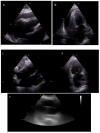Echocardiography in Cardiac Arrest: Incremental Diagnostic and Prognostic Role during Resuscitation Care
- PMID: 39335786
- PMCID: PMC11431641
- DOI: 10.3390/diagnostics14182107
Echocardiography in Cardiac Arrest: Incremental Diagnostic and Prognostic Role during Resuscitation Care
Abstract
Background: Cardiac arrest (CA) is a life-critical condition. Patients who survive after CA go into a defined post-cardiac arrest syndrome (PCAS). In this clinical context, the role of the echocardiogram in recent years has become increasingly important to assess the causes of arrest, the prognosis, and any direct and indirect complications dependent on cardiopulmonary resuscitation (CPR) maneu-vers.
Methods: We have conduct a narrative revision of literature.
Results: The aim of our review is to evaluate the increasingly important role of the transthoracic and transesophageal echocardiogram in the CA phase and especially post-arrest, analyzing the data already present in the literature.
Conclusion: Transthoracic and transesophageal echocardiogram in the CA phase take on important diagnostic and prognostic role.
Keywords: ACLS; CPR; POCUS; ROSC; cardiac arrest; echocardiogram; echocardiography; post-cardiac arrest.
Conflict of interest statement
The authors declare no conflicts of interest.
Figures



Similar articles
-
[An analysis of relevant factors influencing the prognosis of post cardiac arrest syndrome].Zhonghua Wei Zhong Bing Ji Jiu Yi Xue. 2015 Mar;27(3):175-9. doi: 10.3760/cma.j.issn.2095-4352.2015.03.004. Zhonghua Wei Zhong Bing Ji Jiu Yi Xue. 2015. PMID: 25757965 Chinese.
-
Outcomes after cardiac arrest in an adult burn center.Burns. 2013 Dec;39(8):1541-6. doi: 10.1016/j.burns.2013.08.005. Epub 2013 Sep 3. Burns. 2013. PMID: 24011734
-
Point-of-care ultrasound in cardiorespiratory arrest (POCUS-CA): narrative review article.Ultrasound J. 2021 Dec 2;13(1):46. doi: 10.1186/s13089-021-00248-0. Ultrasound J. 2021. PMID: 34855015 Free PMC article. Review.
-
[Clinical effect of cardiopulmonary resuscitation with active abdominal compression-decompression].Zhonghua Wei Zhong Bing Ji Jiu Yi Xue. 2019 Feb;31(2):228-231. doi: 10.3760/cma.j.issn.2095-4352.2019.02.021. Zhonghua Wei Zhong Bing Ji Jiu Yi Xue. 2019. PMID: 30827315 Chinese.
-
Echocardiography in cardiac arrest: An emergency medicine review.Am J Emerg Med. 2018 Mar;36(3):488-493. doi: 10.1016/j.ajem.2017.12.031. Epub 2017 Dec 16. Am J Emerg Med. 2018. PMID: 29269162 Review.
Cited by
-
Heart Failure and Wide QRS: Clinical and Pharmacological Perspectives.Biomedicines. 2025 Jun 13;13(6):1462. doi: 10.3390/biomedicines13061462. Biomedicines. 2025. PMID: 40564182 Free PMC article. Review.
-
Relationship Between Left Atrial Strain and Atrial Fibrillation: The Role of Stress Echocardiography.Diagnostics (Basel). 2024 Dec 24;15(1):7. doi: 10.3390/diagnostics15010007. Diagnostics (Basel). 2024. PMID: 39795535 Free PMC article. Review.
-
Obesity Paradox in Takotsubo Syndrome Among Septic ICU Patients: A Retrospective Cohort Study.J Clin Med. 2025 Apr 11;14(8):2635. doi: 10.3390/jcm14082635. J Clin Med. 2025. PMID: 40283464 Free PMC article.
-
Takotsubo Syndrome and Oxidative Stress: Physiopathological Linkage and Future Perspectives.Antioxidants (Basel). 2025 Apr 27;14(5):522. doi: 10.3390/antiox14050522. Antioxidants (Basel). 2025. PMID: 40427405 Free PMC article. Review.
References
-
- Yow A.G., Rajasurya V., Ahmed I., Sharma S. Sudden Cardiac Death. StatPearls; St. Petersburg, FL, USA: 2024. [(accessed on 28 May 2024)]. Available online: https://www.ncbi.nlm.nih.gov/books/NBK507854/ - PubMed
-
- Nolan J.P., Sandroni C., Böttiger B.W., Cariou A., Cronberg T., Friberg H., Genbrugge C., Haywood K., Lilja G., Moulaert V.R.M., et al. European Resuscitation Council and European Society of Intensive Care Medicine Guidelines 2021: Post-resuscitation care. Resuscitation. 2021;161:220–269. doi: 10.1016/j.resuscitation.2021.02.012. - DOI - PubMed
Publication types
LinkOut - more resources
Full Text Sources

